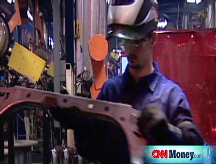Automaker plan in Bush's court
GM and Chrysler could get a total of $15 billion by Dec. 15 as part of a proposed bailout. White House and Congress in negotiations.
NEW�YORK (CNNMoney.com) -- There's no indication when - or if - the White House and congressional leaders will reach agreement on the Democrats' proposal to give troubled U.S. automakers a financial lifeline.
Meanwhile, one key General Motors official is already talking about the need for more help from the government - even before this package is approved.
A senior administration official told CNN that language to modify the proposal was discussed until late Monday. Some Republicans have been critical of the plan, saying it doesn't have enough assurances of automakers viablility.
The companies could get a total of $15 billion in federal loans as soon as Dec. 15, according to a working Democratic draft of proposed legislation and a senior Democratic congressional aide.
The proposal, which was delivered to the White House Monday afternoon, remains a work in progress. The bailout was worked on through the weekend on Capitol Hill in an effort to produce a bill that the Bush administration could agree to.
A Democratic source conceded to CNN that the White House has concerns with the proposal but that House and Senate staffs sent a revised draft of the proposal to the White House Monday night. The aim is to finalize a bill for a quick vote by Congress, which is meeting this week in a lame-duck session.
"[This is] a fundamental step towards an agreement," said Rep. Barney Frank, D-Mass., chairman of the House Financial Services Committee. "If there is a real desire to get this thing done and prevent adding another disaster to our economic situation, we should have it."
The Democrats' bill met some immediate Republican opposition. Sen. Bob Corker, R-Tenn., said "at first glance" the proposal was "lacking the benchmarks" it needs to make sure the companies stay afloat.
If the aid package is passed, it could avert the need for General Motors (GM, Fortune 500) and Chrysler LLC to file for bankruptcy and halt operations.
The money is less than the $34 billion requested by the industry last week, but the proposed plan would give the new Congress and the incoming Obama administration time to hammer out a longer-range plan to help the industry.
The money would come out of funds designated by the Energy Independence and Security Act to help the auto industry produce the next generation of fuel efficient vehicles. Democrats had wanted funding for an automaker rescue to come from the Treasury Department's $700 billion Troubled Asset Relief Program, but the Bush administration balked.
But according to Democratic leadership, the Energy Act only allows for $15 billion to be delivered to the industry, since the loan would be "risky."
"This is a bad choice we have to make," said House Speaker Nancy Pelosi, D-Calif. "But come Mar. 31, it is our hope that there will be a viable automotive industry in our country, with transparency and accountability to the taxpayer. We think that it is possible."
The Bush administration said Monday evening that it was continuing its talks with lawmakers.
"Long-term financing must be conditioned on the principle that taxpayers should only assist automakers executing a credible plan for long-term viability," said White House press secretary Dana Perino.
GM Vice Chairman of Global Development Bob Lutz told CNN's American Morning that he expects the industry to go back to Washington next year for more money.
"I don't think anybody in Congress or the president-elect assumes that this is all the money that is going to be required to bridge this liquidity crisis that the American automobile industry is facing," Lutz said.
Under the proposal being reviewed by the White House, the president would appoint an individual to write the guidelines for the loan, due by Jan. 1, and oversee the bailout. This person - a so-called "car czar" - would essentially be in charge of setting the terms for restructuring the Big Three automakers.
The official would have authority to negotiate with unions, debt holders, suppliers and other "interested parties" to help work out restructuring plans.
The plan would also give the Government Accountability Office a special role in overseeing the program.
Under the proposal, the government would receive warrants - the right to buy a stake in the companies at a certain price - equal to 20% of the loan's value. That means taxpayers would take a significant share of GM, which has asked for $10 billion in loans.
The companies would also have to drop their lawsuits against individual states that have passed laws on emissions standards that are more extensive than the federal government's.
GM, Chrysler and Ford Motor (F, Fortune 500) have been asking for loans to help them survive until 2010, when some cost cuts and labor contract savings kick in that could help the Big Three eventually return to profitability.
In a statement, GM said it is pleased lawmakers are working on a bill that would give the industry immediate assistance.
"Millions of jobs, America's manufacturing base and future competitiveness hang in the balance and we urge quick passage of this bill," the statement said.
Chrysler echoed GM, saying it looks forward to working with Congress so that it can complete its restructuring process in an "orderly fashion."
GM and Chrysler have warned that they could soon run out of the cash they need for operations without assistance from the government. Ford has said it has enough cash on hand for now and may not need the federal help but that it would still like the funds to be available as a backstop.
-- CNN Correspondents Dana Bash and Kathleen Koch contributed to this story. ![]()



